Locust Grove is the name of a number of places in the United States of America:
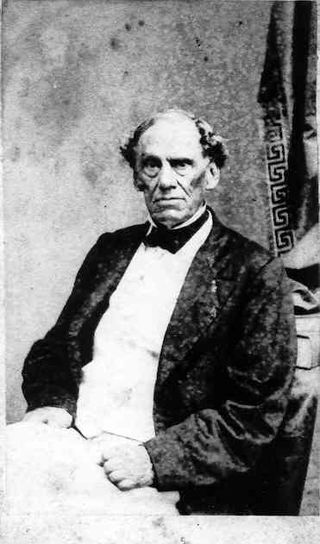
Bedford Brown was a Democratic United States Senator from the State of North Carolina between 1829 and 1840.

John Haywood was an American politician, who was the longest-serving North Carolina State Treasurer.
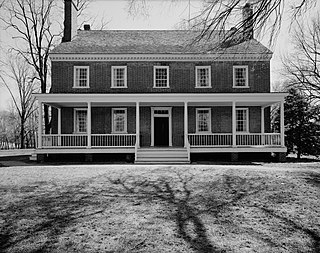
Historic Locust Grove is a 55-acre 18th-century farm site and National Historic Landmark situated in eastern Jefferson County, Kentucky in what is now Louisville. The site is owned by the Louisville Metro government, and operated as a historic interpretive site by Historic Locust Grove, Inc.

Horton Grove was an area of houses for enslaved African-Americans at the 30,000-acre (120 km2) Bennehan-Cameron plantation complex, which included Stagville Plantation in the northeastern part of Durham County, North Carolina. The slaves who lived at Horton Grove were held by the influential Bennehan and Cameron families. In 1860, 900 total slaves were held on the complex. The several structures still standing at Horton Grove are the only two-story slave residences remaining in North Carolina.
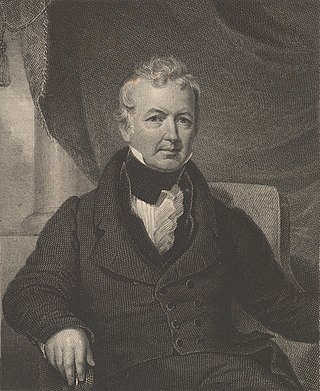
William J. Gaston was a jurist and United States Representative from North Carolina. He was the author of the official state song of North Carolina, "The Old North State". Gaston County, North Carolina, created just after his death, was named for him, as later were the city of Gastonia, North Carolina, artificial Lake Gaston, and the Gaston Hall auditorium at his alma mater, Georgetown University.

Stagville Plantation is located in Durham County, North Carolina. With buildings constructed from the late 18th century to the mid-19th century, Stagville was part of one of the largest plantation complexes in the American South. The entire complex was owned by the Bennehan, Mantack and Cameron families; it comprised roughly 30,000 acres (120 km2) and was home to almost 900 enslaved African Americans in 1860.

Locust Grove is a National Historic Landmark estate located on US 9 in the Town of Poughkeepsie, New York. The 200-acre park-like estate includes homes, a carriage house, ice house, trails, a flower garden, and vegetable garden, and it overlooks the Hudson River from a bluff. The property includes a home designed by architect Alexander Jackson Davis for Samuel F. B. Morse, the inventor of the telegraph. An Italianate style mansion, it was completed in 1851.

Ingleside is an unincorporated community in northern Franklin County, North Carolina, United States. It lies at the intersection of U.S. Route 401, and North Carolina Highway 39, north of Louisburg, at an elevation of 394 feet.

Bentonville Battlefield is a North Carolina state historic site at 5466 Harper House Road in Johnston County, North Carolina. It belongs to the North Carolina Department of Natural and Cultural Resources and is the site of the 1865 Battle of Bentonville, fought in the waning days of the American Civil War. It was declared a National Historic Landmark in 1996.

Locust Grove is a historic house located between Dillwyn and Cumberland, Virginia, constructed before 1794. It is remembered for its connection to the Revolutionary soldier Peter Francisco, and as the Peter Francisco House it was added to the National Register of Historic Places on March 16, 1972.
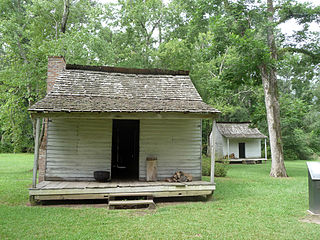
Audubon State Historic Site is a state park property in West Feliciana Parish, Louisiana, between the towns of St. Francisville and Jackson. It is the location where noted ornithologist and artist John James Audubon spent the summer of 1821.
The William T. Vogler Cottage, also known as the Locust Grove Cottage, was a historic home located in Roaring Gap, Alleghany County, North Carolina. It was built in 1908–1909, and was a 1+1⁄2-story Queen Anne style influenced frame cottage. It featured an expansive, wrap-around attached porch. Also on the property were a contributing garage from the 1920s and a yard. It has been demolished.
Walnut Grove, also known as Robeson Plantation, is a historic plantation house complex and national historic district located near Tar Heel, Bladen County, North Carolina. The house was built about 1855, and is a two-story, frame house, five bays wide and four bays deep, in the Greek Revival style. The front and rear facades feature three bay double porches. Also on the property are the contributing dining dependency, kitchen, dairy, smokehouse, barn, well, cold frame, and scalding vat.
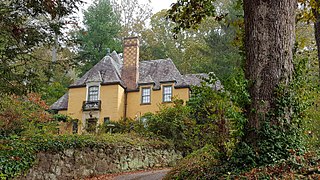
Grove Park Historic District is a national historic district located at Asheville, Buncombe County, North Carolina. The district encompasses 290 contributing buildings and 1 contributing site in a predominantly residential section Asheville. The planned suburban community was originally platted and developed in 1908-1913 and 1914. It includes representative examples of Colonial Revival, Tudor Revival, and Bungalow style dwellings. The community was laid out by noted landscape architect Chauncey Beadle. The Kimberly Amendment to Grove Park was an expansion made to the original Grove Park development in 1923. It includes the former Asheville Country Club, now the Grove Park Inn Country Club.
Moore House, also known as Stamp's Quarter, is a historic home located near Locust Hill, Caswell County, North Carolina. It was built about 1790, and is a two-story, three-bay, Federal style brick dwelling. It is set on a full, raised basement, has exterior end chimneys, and a low hipped roof.
Locust Lawn is a historic tobacco plantation house and national historic district located near Oxford, Granville County, North Carolina. It was built about 1855 by Armistead Ravenscroft Burwell, a descendant of the prominent Burwell Family of Virginia and is a two-story, three-bay, T-shaped Greek Revival style dwelling. It has a two-story rear ell, one-story kitchen wing, brick cellar and central front porch. Also on the property are the contributing six log tobacco barns, two frame barns, frame corncrib, overseer's house, and Burwell Family cemetery.
Magnolia Grove is a historic plantation house located near Iron Station, Lincoln County, North Carolina. It was built about 1824, and is a 2+1⁄2-story, five bay by two bay, style brick dwelling with a Quaker plan interior. It has a gable roof, sits on a full raised basement, and one-story hip-roof porches on the front and rear facades.
John E. Wilson House is a historic home located near Dunn, Sampson County, North Carolina. It was built about 1878, and is a two-story, single pile, Italianate style frame dwelling with a rear ell. It has a center-false-gable roof and is sheathed in weatherboard. The front facade features an intricate double-tier porch. It was built as a boarding house for teachers and students in conjunction with Shady Grove School and has been moved twice, in 1975 and in 1984.















